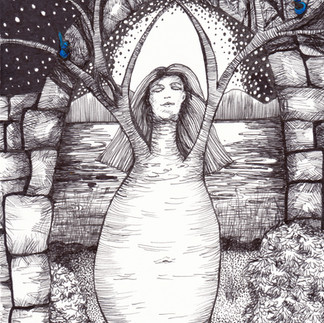Ecofeminism and Art: A Creative Intersection
- Ann Russell
- Sep 3
- 3 min read
Updated: Sep 4
Ecofeminism is an important part of a better future for a number of reasons, which I will make clear later on. Whilst I was studying for my Doctorate, I came to understand that I was undoubtedly an ecofeminist. Ecofeminism is the understanding that the exploitation of women and that of nature are interconnected - essentially, it’s grounded on the idea that the same power that oppresses women (and other marginalised people) oppresses the natural environment, and for similar reasons (Gough & Whitehouse, 2018).
Of course, in some circles, ecofeminism is highly unpopular, combining as it does feminism and ecology. Maybe you rolled your eyes when you read the title of this blog! In our patriarchal, neoliberal world, both are seen as enemies of the consumerist, capitalist systems that our society is based on. Both feminism and environmentalism push against the power structures, particularly of the western world. And often neither are considered crucial issues by power brokers, consequently the proponents of both are often given labels like "left-wing"; "hippy" or "woke".
Ecofeminist art explores various themes such as the interconnectedness of humanity and nature, often by depicting nature as female, such as in my work Gaia. It also explores the idea of strength and empowerment of women, often referring to Goddesses. Ecofeminist art also expresses ideas that are against consumerism and capitalism, referring to the idea that the welfare of humans and nature are linked - we are not outside of nature but part of it. It also asks us to redefine our idea of progress and success.

Ecofeminist art may depict animals, plants and natural scenes not just as aesthetically pleasing or as objects, but exploring the idea of the visceral and spiritual components of the natural world. I honestly believe that we won't survive, much less thrive into the future unless we start to seriously consider the fact that nature is what sustains us, not just a healthy economy, which we don't have anyway.
Unsurprisingly, most ecofeminist artists are female. A well known Australian artist who explores these themes is Patricia Piccinini. Her practice explores the interconnectedness of humanity and nature in a questioning way, rather than being didactic. She wants her audience to question their assumptions about their relationship with the world, which is similar to my desire to undo our understanding of the world and our existence in it as linear and rational.
Ecofeminist art is not the same as Land Art - art that manipulates natural objects such as the works created by Andy Goldsworthy, where he uses ephemeral natural materials. Similar materials may be used by Ecofeminists, but their work is much more relational and less about control. There are many Land artists who are male. The same cannot be said regarding Ecofeminist art.
My work comes from an inner, visceral place that is a response to my understanding to my place in the world. It is aimed at creating a world that we would all much prefer to live in, and I believe that making good consideration of the feminine interconnectedness with nature, we can begin to move towards that eventuality. The state of the world as it stands reinforces the need for a change from the way that society operates.
The following shows some examples of my Ecofeminist art. You can also see a larger version by clicking on the image. I will also soon be releasing a non-fiction book that discusses some of these ideas further, so stay tuned.



























Comments